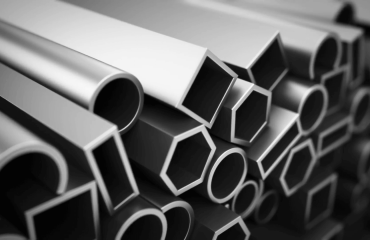Extrusion
is a process used to create objects  of a fixed cross-sectional profile. A material is pushed through a die of the desired cross-section. The two main advantages of this process over other manufacturing processes are its ability to create very complex cross-sections, and to work materials that are brittle, because the material only encounters compressive and shear stresses. It also forms parts with an excellent surface finish.
of a fixed cross-sectional profile. A material is pushed through a die of the desired cross-section. The two main advantages of this process over other manufacturing processes are its ability to create very complex cross-sections, and to work materials that are brittle, because the material only encounters compressive and shear stresses. It also forms parts with an excellent surface finish.
Drawing
is a similar process, which uses the tensile strength of the material to pull it through the die. This limits the amount of change which can be performed in one step, so it is limited to simpler shapes, and multiple stages are usually needed. Drawing is the main way to produce wire. Metal bars and tubes are also often drawn.
Extrusion may be continuous (theoretically producing indefinitely long material) or semi-continuous (producing many pieces). The extrusion process can be done with the material hot or cold. Commonly extruded materials include metals, polymers, ceramics, concrete, modelling clay, and foodstuffs. The products of extrusion are generally called “extrudates”.
Also referred to as “hole flanging”, hollow cavities within extruded material cannot be produced using a simple flat extrusion die, because there would be no way to support the centre barrier of the die. Instead, the die assumes the shape of a block with depth, beginning first with a shape profile that supports the center section. The die shape then internally changes along its length into the final shape, with the suspended center pieces supported from the back of the die. The material flows around the supports and fuses together to create the desired closed shape.
The extrusion process in metals may also increase the strength of the material.
In EAS Aluminium we use hot extrusion process
Hot extrusion is a hot working process, which means it is done above the material’s recrystallization temperature to keep the material from work hardening and to make it easier to push the material through the die. Most hot extrusions are done on horizontal hydraulic presses that range from 230 to 11,000 metric tons (250 to 12,130 short tons). Pressures range from 30 to 700 MPa (4,400 to 101,500 psi), therefore lubrication is required, which can be oil or graphite for lower temperature extrusions, or glass powder for higher temperature extrusions. The biggest disadvantage of this process is its cost for machinery and its upkeep.
Die design
The design of an extrusion profile has a large impact on how readily it can be extruded. The maximum size for an extrusion is determined by finding the smallest circle that will fit around the cross-section, this is called the circumscribing circle. This diameter, in turn, controls the size of the die required, which ultimately determines if the part will fit in a given press. For example, a larger press can handle 60 cm (24 in) diameter circumscribing circles for aluminium and 55 cm (22 in) diameter circles for steel and titanium
The complexity of an extruded profile can be roughly quantified by calculating the shape factor, which is the amount of surface area generated per unit mass of extrusion. This affects the cost of tooling as well as the rate of production.
Thicker sections generally need an increased section size. In order for the material to flow properly legs should not be more than ten times longer than their thickness. If the cross-section is asymmetrical, adjacent sections should be as close to the same size as possible. Sharp corners should be avoided; for aluminium and magnesium the minimum radius should be 0.4 mm (1/64 in) and for steel corners should be 0.75 mm (0.030 in) and fillets should be 3 mm (0.12 in).



